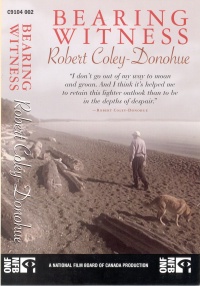| ________________
CM . . .
. Volume XI Number 2 . . . . September 17, 2004
excerpt:
Bearing Witness: Robert Coley-Donohue is a video about the final three years of life of a Canadian man who is slowly dying with ALS (amylotrophic lateral sclerosis) or Lou Gehrig's disease. Not long after Robert's own diagnosis with this ultimately fatal, degenerative neuromuscular disease, his wife, Barbara, was also diagnosed with ALS. She died before the filming of this video and relatively little is told of her experience with this catastrophic disease. The incidence of ALS is 2 in every 100,000 people and every day 2 to 3 Canadians die with ALS. In the video, we sense how much Robert misses his late wife, whom he describes as having been his "navigator." Some clips from old home movie footage from years gone by show summer vacations taken by the couple and their three youngsters. We are given a clear impression of a loving, close-knit, happy family. Robert's adult children, two sons and a daughter, remain close at hand as he "gets on with" his ALS journey. We see clearly that his children are respectful of their father's wishes, completely patient with him through his failing health, and resolutely there for him. Through a series of one-on-one interviews, we see how each person in the family has come to terms with the devastating losses that ALS has brought about in their lives. Purchased after his wife dies, Robert's dog Brandy is a faithful companion, always eager to go out for a walk. We see Robert going walking, and then, after quite some time, using a motorized wheelchair in order to enjoy the outdoors with his dog. As the activities of daily living (ADLs) become more and more tiring for him, he remains ambulatory, but his paralyzed arms hang straight down and his neck is bent. The needed home care support is increased over time in consultation with Robert and his family. Robert makes the choice to continue to live in his own home in Victoria, BC, for as long as possible. He is able to do this with publicly-funded home care support, together with privately-funded care, as well as the moral support of his family and best friend. At one stage of Robert's illness, his sons become the administrators of the home care team. As the ALS takes its slow but inexorably deadly toll, Robert has to make some hard choices. For example, as swallowing becomes increasingly difficult, he decides to have a stomach tube put through the abdomen directly into his stomach. This surgical procedure allows for direct food delivery with the assistance of an attendant. Eventually, Robert chooses to leave his own home behind and enter a hospital for the elderly. His family and his dog continue to visit him there. He is able to see and welcome his newest grandchild into the world before he passes away. This 90 minute National Film Board video is highly recommended for viewing by the families of people diagnosed with ALS, as well as by other caregivers of people with ALS, social workers and those who are training as social workers, home care case managers, and those studying palliative care and thanatology. By filming Robert Coley-Donohue's story, the director created an invaluable resource for others whose lives are affected by the most common cause of neurological death in Canada. Highly Recommended. Cathy Vincent-Linderoos is a member of the Ontarians with Disabilities Act Committee. She has MS and is a disability rights activist who lives in London, ON.
To comment
on this title or this review, send mail to cm@umanitoba.ca.
Copyright © the Manitoba Library Association. Reproduction for personal
use is permitted only if this copyright notice is maintained. Any
other reproduction is prohibited without permission.
NEXT REVIEW |TABLE OF CONTENTS FOR THIS ISSUE
- September 17, 2004.
AUTHORS
| TITLES | MEDIA REVIEWS
| PROFILES
| BACK ISSUES
| SEARCH | CMARCHIVE
| HOME |
